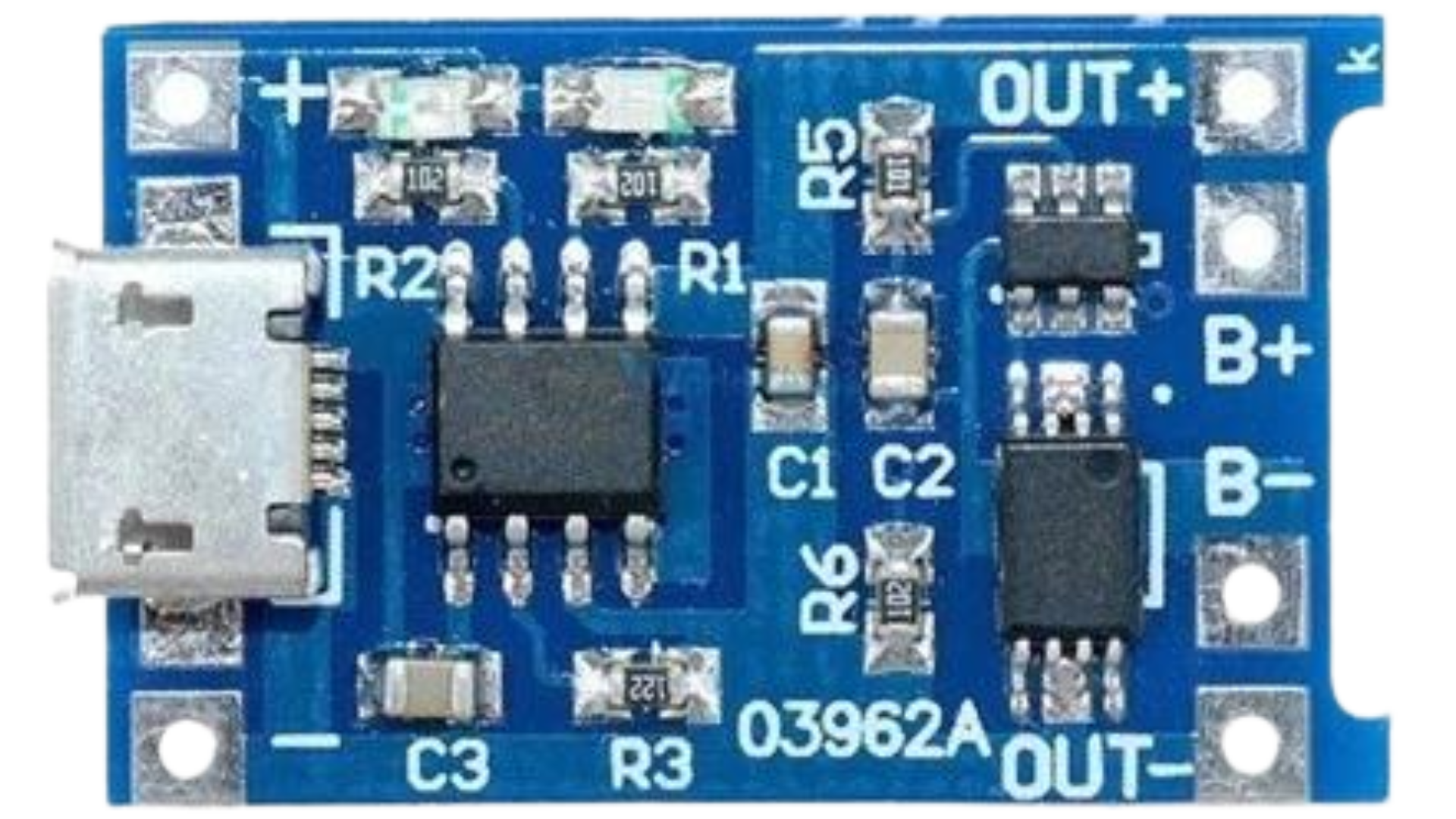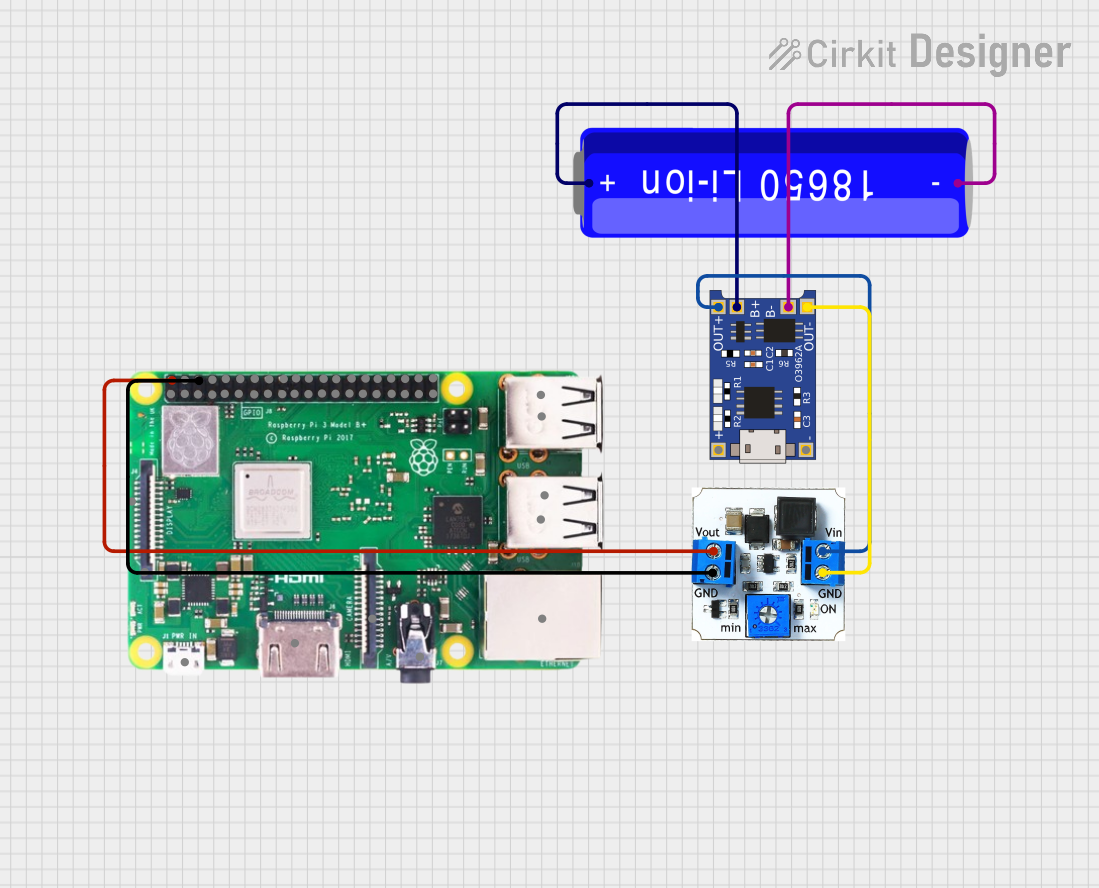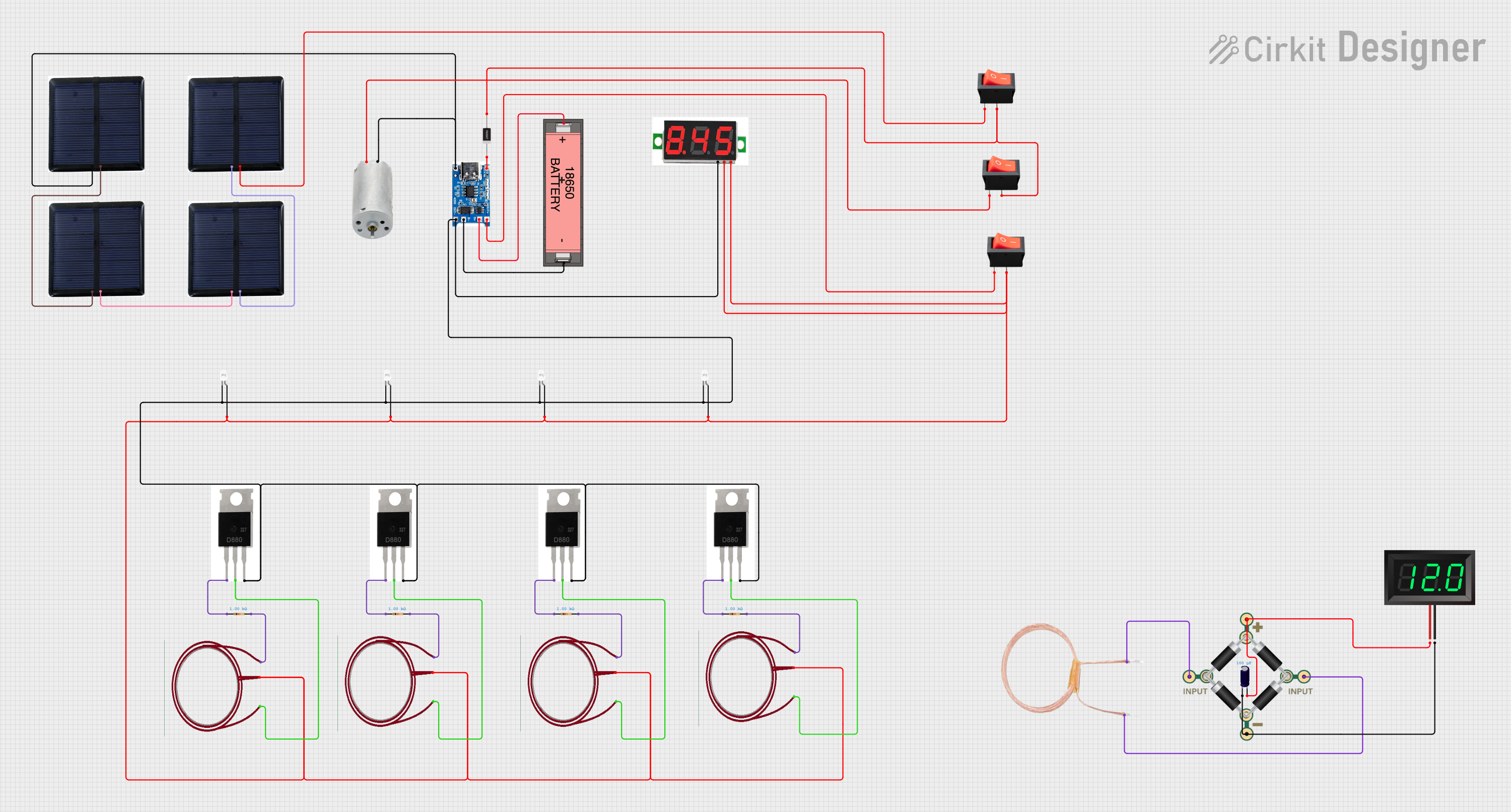
How to Use TP4056 Charging Module: Examples, Pinouts, and Specs

 Design with TP4056 Charging Module in Cirkit Designer
Design with TP4056 Charging Module in Cirkit DesignerIntroduction
The TP4056 Charging Module is a compact and efficient lithium battery charging module designed for single-cell lithium-ion batteries. It utilizes a constant current/constant voltage (CC/CV) charging method to ensure safe and reliable charging. The module features overcharge protection, a micro USB input for convenience, and onboard LED indicators to display the charging status. Its small size and ease of use make it a popular choice for DIY electronics projects, portable devices, and battery-powered systems.
Explore Projects Built with TP4056 Charging Module

 Open Project in Cirkit Designer
Open Project in Cirkit Designer
 Open Project in Cirkit Designer
Open Project in Cirkit Designer
 Open Project in Cirkit Designer
Open Project in Cirkit Designer
 Open Project in Cirkit Designer
Open Project in Cirkit DesignerExplore Projects Built with TP4056 Charging Module

 Open Project in Cirkit Designer
Open Project in Cirkit Designer
 Open Project in Cirkit Designer
Open Project in Cirkit Designer
 Open Project in Cirkit Designer
Open Project in Cirkit Designer
 Open Project in Cirkit Designer
Open Project in Cirkit DesignerCommon Applications
- Charging single-cell lithium-ion batteries (3.7V nominal, 4.2V fully charged)
- Power banks and portable chargers
- Wearable devices and IoT projects
- Battery-powered electronics and DIY projects
Technical Specifications
Key Technical Details
- Input Voltage: 4.5V to 5.5V (via micro USB or IN+ and IN- pins)
- Charging Voltage: 4.2V ± 1%
- Charging Current: Adjustable, default 1A (via onboard resistor)
- Battery Type: Single-cell lithium-ion battery
- Overcharge Protection: Yes (stops charging at 4.2V)
- Over-discharge Protection: Yes (disconnects load below 2.5V)
- Overcurrent Protection: Yes
- LED Indicators:
- Red LED: Charging
- Blue LED: Fully charged
- Module Dimensions: 25mm x 19mm x 10mm (approx.)
Pin Configuration and Descriptions
| Pin Name | Description |
|---|---|
| IN+ | Positive input voltage (4.5V to 5.5V). Can be connected to a power source. |
| IN- | Negative input voltage (ground). |
| BAT+ | Positive terminal of the lithium-ion battery. |
| BAT- | Negative terminal of the lithium-ion battery. |
| OUT+ | Positive output terminal for the load (connected to the battery). |
| OUT- | Negative output terminal for the load (connected to the battery). |
Usage Instructions
How to Use the TP4056 Charging Module
Connect the Power Source:
- Use a micro USB cable to connect the module to a 5V power source (e.g., USB adapter, power bank, or computer).
- Alternatively, connect a 4.5V to 5.5V DC power source to the IN+ and IN- pins.
Connect the Battery:
- Connect the positive terminal of the lithium-ion battery to the BAT+ pin.
- Connect the negative terminal of the battery to the BAT- pin.
Monitor the Charging Status:
- The red LED will light up during charging.
- The blue LED will light up when the battery is fully charged.
Optional Load Connection:
- If you want to power a load while charging the battery, connect the load to the OUT+ and OUT- pins. Note that the module includes over-discharge protection to prevent battery damage.
Important Considerations and Best Practices
- Ensure the battery being charged is a single-cell lithium-ion battery with a nominal voltage of 3.7V.
- Do not exceed the module's input voltage range (4.5V to 5.5V) to avoid damage.
- The default charging current is 1A. If your battery has a lower maximum charging current, replace the onboard resistor (R3) to adjust the charging current accordingly.
- Avoid short-circuiting the BAT+ and BAT- pins, as this can damage the module and the battery.
- Ensure proper heat dissipation if the module is used for extended periods or with high charging currents.
Example: Using the TP4056 with an Arduino UNO
The TP4056 module can be used to charge a battery that powers an Arduino UNO. Below is an example of how to monitor the battery voltage using the Arduino's analog input.
Circuit Diagram
- Connect the TP4056 module to a 3.7V lithium-ion battery.
- Connect the OUT+ and OUT- pins of the TP4056 to the Arduino's VIN and GND pins, respectively.
- Use a voltage divider circuit to scale the battery voltage to a range suitable for the Arduino's analog input (0-5V).
Arduino Code
// Define the analog pin connected to the voltage divider
const int voltagePin = A0;
// Define the voltage divider ratio (e.g., R1 = 10k, R2 = 10k)
const float voltageDividerRatio = 2.0;
// Define the reference voltage of the Arduino (5V for most boards)
const float referenceVoltage = 5.0;
void setup() {
Serial.begin(9600); // Initialize serial communication
}
void loop() {
// Read the analog value from the voltage divider
int analogValue = analogRead(voltagePin);
// Convert the analog value to the actual battery voltage
float batteryVoltage = (analogValue * referenceVoltage / 1023.0) * voltageDividerRatio;
// Print the battery voltage to the Serial Monitor
Serial.print("Battery Voltage: ");
Serial.print(batteryVoltage);
Serial.println(" V");
delay(1000); // Wait for 1 second before the next reading
}
Troubleshooting and FAQs
Common Issues and Solutions
The module gets hot during operation:
- This is normal for the TP4056 module, especially when charging at high currents. Ensure proper ventilation and avoid touching the module during operation.
The battery does not charge:
- Verify the connections to the BAT+ and BAT- pins.
- Ensure the input voltage is within the specified range (4.5V to 5.5V).
- Check if the battery is damaged or has a protection circuit that prevents charging.
The red LED does not light up:
- Ensure the power source is connected and providing sufficient voltage.
- Check for loose or incorrect connections.
The blue LED does not light up after charging:
- The battery may not be fully charged yet. Allow more time for charging.
- Verify the battery's capacity and the charging current to estimate the charging time.
FAQs
Can I use the TP4056 module to charge multiple batteries in series?
- No, the TP4056 is designed for single-cell lithium-ion batteries only. Charging multiple batteries in series requires a specialized balance charger.
How do I adjust the charging current?
- Replace the onboard resistor (R3) with a different value. Refer to the TP4056 datasheet for the resistor-to-current mapping.
Can I use the module without a battery?
- No, the TP4056 is designed to charge a battery and may not function correctly without one connected.
Is it safe to leave the battery connected to the module after charging?
- Yes, the module includes overcharge protection and will stop charging once the battery reaches 4.2V. However, it is good practice to disconnect the battery if not in use for extended periods.